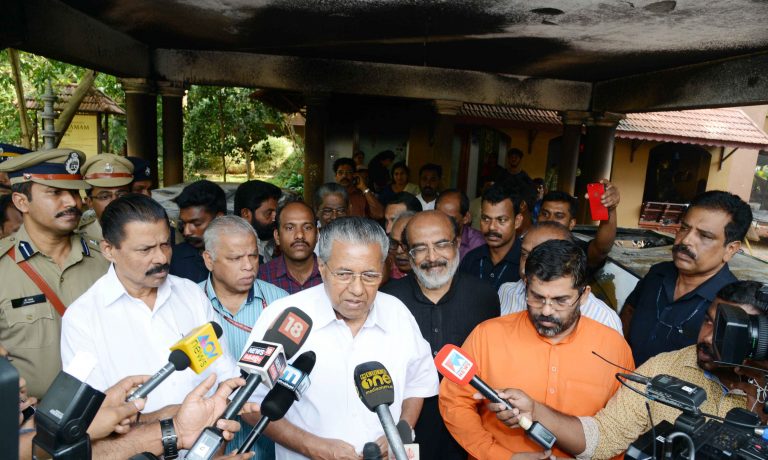
Above: Chief Minister Pinarayi Vijayan is being blamed for curtailing media freedom in Kerala/Photo: UNI
Courts in Kerala have stepped in as saviours in several cases where authorities misused their power to throw out employees for merely expressing opinions on social media
By NV Ravindranathan Nair in Thiruvananthapuram
The recent judgments by the Kerala High Court are pointers to the trend of democratically elected leaders and others in positions of power in the state becoming increasingly intolerant of comments or views expressed on social media platforms. Recently, the Court directed the Travancore Devaswom Board (TDB) to reinstate a temple employee who was under suspension for a Facebook post, which had allegedly insulted Chief Minister Pinarayi Vijayan and Devaswom Minister Kadakampally Surendran.
Days later, the Court again stepped in to reinstate a professor who had been removed by the Central University of Kerala for expressing his opinion in a Facebook post. In the post, the professor had criticised the University authorities for suspending a Dalit student. The Court ordered that the professor be reinstated on the ground that expressing an opinion on social media cannot be considered criticism. (see box).
In the first case, while disposing of a plea by Vishnu RC, who was working as a panchavadyam (percussionist) in a temple under the Kerala government-controlled TDB, Justice PV Asha in her order said that going by the nature of the allegations levelled against Vishnu, it was not necessary “to keep him outside anymore”.
In a Facebook post, Surendran had stated that he would initiate criminal proceedings against Vishnu, who had shared a photoshopped image of himself and the chief minister in his Facebook post.
However, Vishnu’s lawyer, Ramesh V Ramakrishnan, made the minister’s post an exhibit to contend that the order of suspension by the TDB was issued at his instigation. He claimed that Vishnu did not indulge in any misconduct.
Justice Asha in her judgment said, “As the order of suspension has been passed as early as on 1.10.2018, I don’t find it necessary to go into the allegations and counter allegations. Going by the nature of allegations against the petitioner it need not be necessary to keep him outside anymore. A memo of charge is already issued to him on 3 November 2018.” The Court also noted that the petitioner had already issued an explanation on the matter.
 In view of the above circumstances, the Court ruled that the writ petition be disposed of and directed the TDB to reinstate Vishnu within one week from the date of receipt of the judgment copy.
In view of the above circumstances, the Court ruled that the writ petition be disposed of and directed the TDB to reinstate Vishnu within one week from the date of receipt of the judgment copy.
Surendran was at the centre of yet another row when, on November 22, a temple priest was suspended after he allegedly posted abusive comments on social media against the minister over the Sabarimala issue. Action was taken against T Madhavan Namboothiri, the chief priest of a temple in district Kasaragod on the basis of the comments. The Malabar Devaswom Board, which runs the temple, was asked to suspend the priest though he was a trustee of the temple.
Never has Kerala been so divided along religious lines as in recent times, particularly after the Supreme Court verdict that allowed women of all ages to enter the Sabarimala temple. The spectre of violence has haunted large parts of the state and there are reports that the chief minister, a tough, no-nonsense administrator with little concern for democratic values and traditions, has asked the concerned authorities to come down heavily on employees for their social media posts. It is a move that has once again exposed the growing trend of intolerance, and comes in addition to the guidelines that the state government has already issued for mediapersons. These have effectively curtailed their freedom of movement as well as their right to work.
The guidelines have imposed stringent restrictions on mediapersons for covering press conferences, official programmes inside and outside the state secretariat, and entry into the public relations department office of the government. The new rules, which in effect have put the state information and public relations department incharge of communication between the government and the media, has also imposed restrictions on mediapersons directly seeking responses from the chief minister, ministers and other prominent personalities at airports, railway stations and guest houses.
The journalists in the state are protesting against these draconian moves to infringe on their right to work, thereby clipping media freedom. And they have got full support from the Congress-led Opposition. However, by alternately wielding the carrot and stick, the state government has been able to cover up the protest and prevent it from getting national attention.
All these cases are pointers that people in power, be it a minister, chief minister or a vice-chancellor, while holding constitutional posts or heading democratic institutions, lose no time in throttling freedom of expression.

